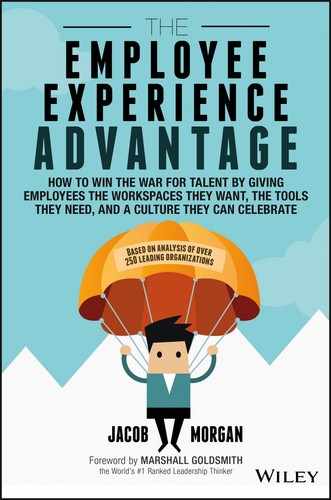CHAPTER 20
The Employee Experience Pyramid
I like to think of employee experience as a pyramid that has various tiers that sit on top of one another (see Figure 20.1).

Figure 20.1 The Employee Experience Pyramid
At the base of the pyramid, we have the Reason for Being, which provides the foundation for how the organization approaches and thinks about employee experience. The Reason for Being is ultimately what connects the people to the organization. For example, look at the Reason for Being for Starbucks (a preExperiential Organization), which is “To inspire and nurture the human spirit – one person, one cup, and one neighborhood at a time.” When an organization makes a statement like that, you can and should expect that it has an attitude of caring about its people. Of course, there are plenty of exceptions to this. Look at Apple, which scored in the Experiential Category yet has absolutely no Reason for Being. Its current mission statement is: “Apple designs Macs, the best personal computers in the world, along with OS X, iLife, iWork and professional software. Apple leads the digital music revolution with its iPods and iTunes online store.”
Compare that with the Reason for Being Steve Jobs first instilled at the company in the 1980s, which was “To make a contribution to the world by making tools for the mind that advance humankind.”
Those are two radical statements and commitments from the same organization, and it's not surprising that so many people today believe that Apple has lost its way and is struggling with creating new and innovative products. A powerful Reason for Being forces the organization to commit to delivering great employee (and almost always customer) experiences. It makes the organization accountable, especially in this transparent world we live in.
On top of that we have the three employee experience environments, which are culture, technology, and the physical environment. Everything and anything your organization will ever do concerning employee experience will fall into these three environments. This includes compensation and benefits enhancements, flexible work programs, management training, the tools that employees use to get their jobs done, and everything in between. Thinking of employee experience as a combination of these three environments will dramatically help simplify things.
Then we have the 17 variables that make up those environments, which are COOL spaces (Chapter 5), ACE technology (Chapter 6), and a CELEBRATED culture (Chapter 7). Based on my analysis these are the 17 things that employees care about and value most in their organizations. Through investments in people analytics, your organization will be able to determine any changes in these 17 variables over time. Remember that as the world continues to evolve, so must our approaches to and strategies for providing employee experiences.
At the very top of the pyramid, we have the moments that matter. These allow organizations to personalize the employee experience as much as possible. Organizations do this by identifying the key moments in the life of an employee and then infusing the 17 variables into those moments whenever possible. Leveraging multiple feedback mechanisms allows organizations to more effectively and accurately identify these moments. The moments will differ by organization, which is why it's so crucial to ask employees, and to keep asking them, because these moments can absolutely change.
The employee experience pyramid helps put into perspective how the various elements fit and work together, kind of like a jigsaw puzzle. The best companies execute on all of these things.
